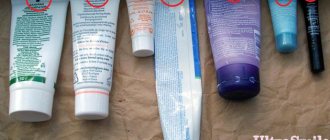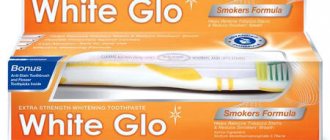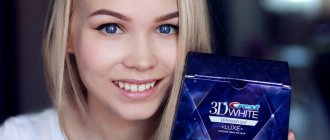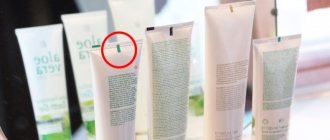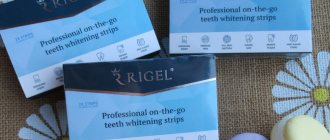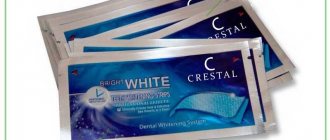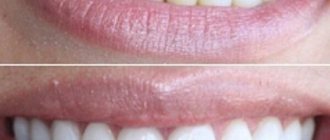Share
Tell
Share
Tweet
Share
Have you ever noticed the multi-colored stripes on tubes of creams, toothpastes, shampoos and other care products? Some people believe that the color of this rectangle indicates what the product is made of. Like, if it is black, then the cosmetics consists of 100% chemicals, and if it is green, then these are natural ingredients and an eco-product. This funny misunderstanding has been widely circulated on the Internet, so many continue to believe that the color of this stripe really means something. It's time to destroy this myth.
Popular versions and hypotheses - the main myths about multi-colored marks on tubes
In an attempt to unravel the meaning of the multi-colored stripes on tubes of toothpaste, consumers came up with many different versions and hypotheses. It must be said right away that these are just guesses, popular misconceptions that do not correspond to reality. Let's first look at the common versions, and therefore move on to the question of what the markings on the tube actually mean.
Composition of contents – safety of active components
This is one of the most common hypotheses. Its essence is that the strip on the packaging draws the buyer’s attention to the presence or absence of natural ingredients in the product. There is an opinion among the population that the color of the mark can have the following meanings:
- a black mark indicates that the composition of the product includes only artificial components, and there are no natural ingredients in it,
- blue indicates the presence of natural ingredients in the product, but their content does not exceed 20%,
- the red marking indicates that the product is half natural, that is, the content of natural components reaches 50%,
- green - a guarantee that the product is completely organic, and only plant ingredients were used in its production.
There is a myth that the color of the stripes indicates the safety of the active ingredients.
It is not known where this rumor came from, but it has nothing to do with the truth. To make sure the composition is safe, pay attention to the list of ingredients on the package, including the small print.
Recommendations for duration of use
Another theory suggests that the stripe on the seam of the tube is directly related to recommendations regarding the duration of use of the product. If preventive pastes are suitable for daily use, then therapeutic and whitening pastes should be used in time-limited courses. This is the gradation proposed by the hypothesis:
- blue mark – prophylactic for daily use,
- green – the paste helps strengthen dental tissues, but can be used for no longer than a month,
- red - the composition is saturated with potent medicinal components, so you can brush your teeth with it for no longer than a week,
- black – a whitening agent, it is recommended to use as needed and in short courses so as not to damage the enamel.
There is a misconception that the color indicates the duration of brushing your teeth.
There is no connection between the color of the strip and the purpose of the cosmetic product. In fact, this label does not carry any useful information for the consumer.
The presence of dyes in the composition
If you believe this interpretation, then the green stripe means that the composition is completely natural, and any other color indicates the opposite. Some adherents of this theory argue that a red, black, blue or even white stripe on toothpaste is a clear sign that the product contains artificial colors. Perhaps this is another trick of marketers who are well aware of the strong association of the color green with nature and natural ingredients.
Some people believe that the colored lines indicate the naturalness of the ingredients.
Efficacy in the treatment of periodontal disease
Another fairly popular misconception is that the color of the strip on the packaging has a direct connection with the properties of the paste, in particular its effectiveness in treating periodontal disease. The gist is this: a black mark indicates the absence of any components necessary to treat the disease, a red mark means the composition contains chemicals that meet local quality standards, a green mark means the composition is completely safe. The connection between these definitions is difficult to logic, but the version still gained popularity.
Degree of abrasiveness
According to another theory, the markings indicate the degree of abrasiveness of the paste. Thus, black, blue, and sometimes brown colors indicate that the composition contains coarse abrasive particles in high concentration. You can only brush your teeth with this product for a short time - for noticeable whitening of the enamel.
“A work colleague once blurted out to me that the colored green tail on a tube of toothpaste means that it contains natural ingredients and is therefore suitable for sensitive teeth. Well, I bought it on my own. I think it’s great, and it also has a whitening effect. As a result, the enamel began to react even more strongly to everything. Then smarter people explained to me that all this was nonsense! There is no connection at all!”
Irka!13, from correspondence on the woman.ru forum
Red markings indicate the presence of abrasive components, but in small quantities. Green is a sign that the composition does not contain abrasive particles, and the product can be safely used every day without fear of its negative effect on the condition of the enamel, even with hyperesthesia, that is, its increased sensitivity.
There is an opinion that the stripes indicate the degree of abrasiveness of the product
Territorial classification
There is also an opinion: marks on the tube indicate the presence and concentration of petroleum products, and also indicate the country where the composition formula was developed. According to this theory, the black mark indicates a high petroleum content and is usually used in Asian countries as well as third world countries. The blue stripe indicates a lower content of harmful substances, and is more often found on products of American brands. Red and green marks indicate low content or complete absence of petroleum products. Such products are produced in European countries.
Cost of components included
The last hypothesis on our list states that the color of the strip directly indicates the quality and cost of the components. If expensive, high-quality ingredients were used in production, there will be a red stripe on the tube. Blue indicates the presence of components of satisfactory quality, black indicates a cheap and low-quality composition.
How to choose a natural product?
When choosing pasta for your family, be very careful and demanding. The fact is that every time a cleaning product is used, its components enter the oral mucosa and, accordingly, are sent into the bloodstream, so the quality of the paste and the safety of its ingredients greatly affect health.
To correctly select the safest toothpaste, we will conduct a comparative analysis of several products from well-known brands, such as: Blendamed, Sensodyne, Aquafresh, etc. We will compare pastes without analyzing them in detail into all their components, but paying attention only to the presence of only three components in them: parabens, SLS and propylene glycol.
| Trademark | Parabens | SLS | Propylene glycol |
| Blendamed | — | + | — |
| ROCS | + | — | — |
| SPLAT | + | + | + |
| Sensodyne | + | — | — |
| Aquafresh | — | + | — |
| President | — | + | + |
| LACALUT | — | + | + |
| Forest balm | + | + | + |
| Siberian Health | — | — | — |
INTERESTING: Lacalut Aktiv toothpaste: instructions and composition, photo
All three substances are contained in SPLAT and Forest Balsam pastes. ROCS and Sensodyne contain parabens, Aquafresh contains the SLS component, President and LACALUT contain propylene glycol and SLS, but none of these substances are present in the Siberian Health paste. Therefore, Siberian Health is the safest and most natural.
The true meaning of the stripes - why they mark the place of adhesion
Regarding why stripes are actually needed on tubes of paste, here you first need to note that similar marks are on all cosmetics that are sold in the same tubes. These markings can come in a variety of colors and be rectangular or square in shape. However, the location of the strip always remains the same - on the tail of the tube.
Such marks are found not only on toothpaste, but also on all cosmetic products.
So, the colored stripes on a toothpaste package have nothing to do with its composition, properties or any other characteristics important to the consumer. The purpose of these marks is very simple - they are standard markings that are applied at the stage of the production process. It is necessary for the proper operation of the conveyor and for cutting blanks for future tubes. There is a special sensor on the conveyor where the workpieces pass. It is he who recognizes the mark and, based on its location, cuts the workpiece. Then the container is sealed on one side and filled with paste.
Alternative theory
mythological meaning is sometimes attributed to flowers on toothpaste :
- Black: composition for whitening tooth enamel. Recommended for use no more than once a week;
- Blue: the mass is suitable for everyday use;
- Red: there is a healing effect. Such products are sold in pharmacies and prescribed by dentists in case of painful teeth;
- Green: designed to consolidate the healing results achieved by the previous composition. Recommended for use within 4 weeks after the treatment course.
Other decryption options are also possible. The gradation of colors is often interpreted as a distribution by price categories of goods, where the green marker is an indicator of an elite and expensive “eco-product”.
Why are the labels on toothpaste colored?
The main thing is that the strip contrasts well with the background, and what color it will be is at the discretion of the manufacturer. Typically, dark marks are applied to light-colored packages so that the sensor can recognize them well. With dark containers the situation is the opposite - you can find light stripes on them.
Important! A standard toothpaste packaging design usually uses 4 primary colors. The barcode, stripes and text on the packaging are printed in a fifth, different color from the others - this creates the necessary contrast and ensures the readability of the printed text. Sometimes the stripes are not installed at all. In such cases, the role of an “identification mark” for the sensor is taken over by one of the design elements.
Obviously, the markings have nothing to do with the quality and composition of the toothpaste. To find out what ingredients it contains, carefully read the ingredients on the package. If the text is written in too small a font, detailed information can be found on the manufacturer's official website.
The marks can be of different colors, the main thing is that they contrast against the background of the tube
List of dangerous components
The presence of these ingredients in the composition indicates a risk to your health:
- parabens (ethylparaben, methylparaben, butylparaben) - substances that tend to accumulate in the body and cause cancer,
- SLS (sodium lauryl sulfate) - can irritate the oral mucosa, promote bleeding gums and hypersensitivity of teeth,
- propylene glycol - can cause irreparable damage to the liver and kidneys, causing cancer.
Although these substances are negligible in modern toothpastes, is it worth the risk when there are a huge number of safe, natural alternative products. In addition to the components used in the analysis, there are a number of dangerous substances, the presence of which makes you think about the advisability of choosing a toothpaste containing them.
Beware if the paste contains:
- SCS - sodium cocosulfate, essentially the same substance as lauryl sulfate,
- glycenophosphate - used as a strengthening agent for tooth enamel and caries prevention, but in large quantities it leads to the opposite effect,
- triclosan is an ordinary antibiotic whose task is to destroy harmful bacteria in the oral cavity, but along with them the product also kills beneficial microflora,
- aluminum lactate - designed to relieve inflammatory processes and prevent bleeding gums, at the same time reduces the sensitivity of tooth enamel to extreme temperatures, which causes teeth to suffer,
- sodium CMC - stabilizer of toothpaste consistency, causes allergic reactions,
- sodium saccharin is an artificial sweetener that is added to create a pleasant taste, is a carcinogen and is not absorbed by the body at all,
- tanium dioxide - the same teeth whitener that dissolves plaque, accumulating in organs, leads to cancer,
- cocamidopropyl betaine - a substance used to make the paste soapy and rich in foam, a powerful carcinogen that causes pathologies of the liver and thyroid gland,
- sodium lauroyl sarcosinate is a substance that removes dirt and creates rich foam, also used in washing powder, an analogue of lauryl sulfate.
Harmful components of toothpaste not only do not strengthen teeth, but destroy them. At the same time, bones and internal organs suffer, and there is a risk of the formation of cancerous tumors in any part of the body.
We don’t eat paste, we just brush our teeth with it! In fact, when brushing our teeth every day throughout our lives, we swallow more than 2.5 kilograms of the product, and along with it harmful components and carcinogens. You need to be especially careful when choosing a cleaning product for children's teeth. After all, kids love sweet, fragrant, colored toothpaste with the smell of strawberries or bubble gum, and eat it with pleasure when brushing their teeth.
GOST requirements for marking
All cosmetics and the containers in which they are sold on the territory of the Russian Federation must meet the strict requirements of GOST1. These documents clearly state what information should be on the packaging:
- the product's name,
- its brand and trademark,
- volume of contents in the container,
- composition listing all ingredients,
- Storage conditions and shelf life,
- availability of certificates.
The labeling on the packaging must be in the language of the manufacturer and the importing country. The indicated mass may have deviations, but not more than 5% of the declared value. The materials from which the packaging is made must be safe for humans and nature as a whole. But in all these documents there is not a word about what the colored stripe on the tube means and how to apply it correctly. In other words, there are no strict rules for applying a color mark. It turns out that this point remains at the discretion of the manufacturing company, which means that it has the right to independently choose the color or do without this designation altogether.
- GOST 7983-99 (based on ISO 11609-95) - correct marking of pasty mass and its designation. GOST 14192 and 28303 – requirements for containers.
Features of container production
Before answering the question regarding the true meaning of squares on containers, you need to provide information about the features of their production.
Creating regular tubes looks like this:
- The polymer blank is cut into pieces of a certain length and width;
- The logo, barcode, manufacturer data and other information are applied to the tube;
- Rolling up a segment that takes the shape of a cylinder;
- Sealing the edges of the sample (on one side);
- Filling the container with cream (or other substance);
- Clogging and sealing of the cylinder;
- The date of manufacture and expiration date are printed on the seam. light mark” is also affixed , thanks to which the machine recognizes the exact location where the cut needs to be made.
The specified sequence of actions is applicable to the process of manufacturing plastic products. The mechanism for creating aluminum tubes is somewhat different, but the placement of a color marker also takes place.
LiveInternetLiveInternet
– Quote book
A tablecloth made of beautiful motifs from VKontakte, KNITTING NEEDLEWORK community.
Beautiful long dress made of motifs. A charming long dress (however, it can be...
Pillowcase made of square roses + detailed step-by-step MK. View: https://appleblossomdreams.
Crochet star pattern and what you can crochet with it! We collect a chain of air loops. .
10 books that will help you find the path to your own perfection 1. Karen Pryor &m.
–Tags
–Categories
- CLOTHING (42)
- STATEMENTS OF GREAT PEOPLE (17)
- DESIGN/INTERIOR (15)
- Children's (1)
- Design ideas (12)
- Kitchen/Dining Room (1)
- Bedroom (1)
- HOUSEHOLDING (12)
- HEALTH (30)
- CREATIVE ITEMS (21)
- NATURAL COSMETICS (40)
- Hair (13)
- Soap making (1)
- Face (20)
- Legs (4)
- Hands (6)
- Body (4)
- UTILITIES (13)
- NATURE (7)
- PSYCHOLOGY (56)
- Self-improvement (33)
- THOUGHTS ABOUT LIFE. (12)
- RECIPES (138)
- Baking (31)
- Fish (11)
- Meat (10)
- Side dishes (10)
- Snacks (40)
- Drinks (2)
- Dishes decoration (24)
- Useful tips (8)
- Seasonings (5)
- Salads (8)
- Sweet (22)
- Sauces (5)
- Soups (5)
- HANDCRAFTS (44)
- crochet (24)
- cutting and sewing (7)
- accessories (6)
- for home (5)
- decorations (3)
- knitting (3)
- gifts and souvenirs (2)
- business stuff (1)
- MOVIES (1)
- ESOTERICA (409)
- Astrology (382)
- Vedas (4)
- Rituals and rituals (8)
- Religion (1)
- Tarot (356)
- Feng Shui (1)
- HUMOR (58)
- Adults (3)
- Sayings (13)
- Children (13)
- Animals (32)
- LEGAL ISSUES (3)
